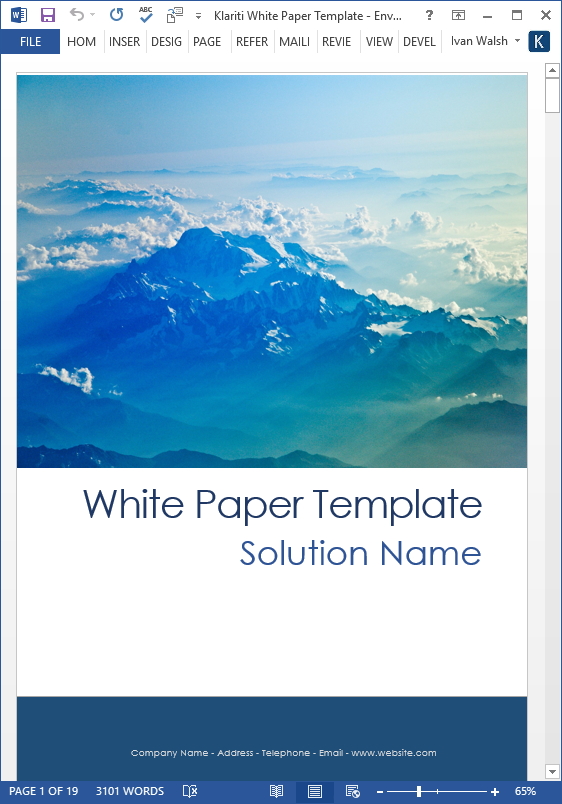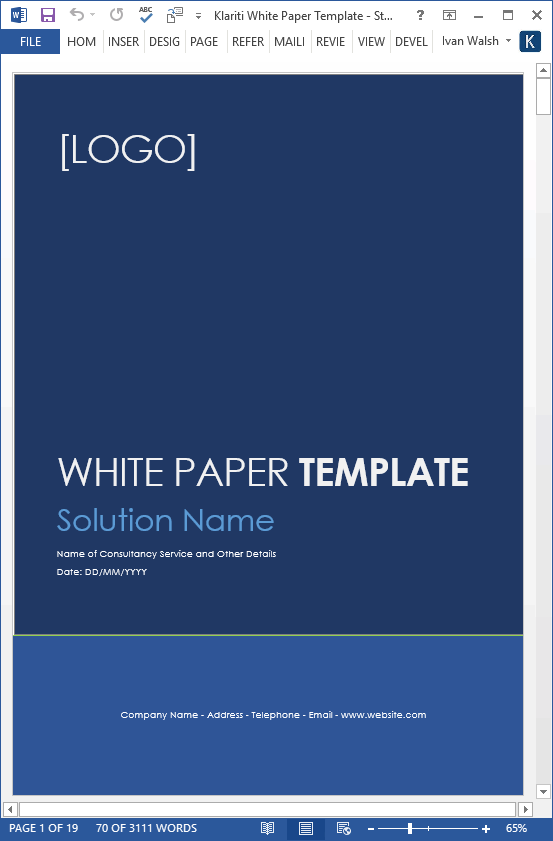White Paper Templates
What is a B2B White Paper?
A B2B White Paper is a document used by sales and marketing teams to generate interest in a specific trend, topic, or technology.
So, how do you write a white paper? Before you start writing, you need to know what it is, right? I know that sounds obvious but one of the difficulties with white papers is that they mean different things to different people.
15 royalty-free MS Word White Paper templates

15 White Paper Templates for only $19.99
What is a White Paper?
One way to make things simple is to create an FAQ and answer the most common questions people have about writing these documents.
Let’s start at the top.
In other words, whereas others sales documents are targeted at customers, journalists, PR, or other sales professionals, white papers are frequently read by those in the Executive level.
What’s the purpose of a white paper?
A white paper discusses a specific:
- Business issue
- Product or
- Competitive situation
In many cases, it summarizes information about a topic, for example the results of a survey and then suggests a proposal for action; the research data provides the justification for the action.
How to define a White Paper?
Definition: A white paper is a high-level marketing document targeted at decision makers.
You can also describe a white paper as follows: ‘A white paper helps you to understand an issue, solve a problem, or do your job better.’
White papers tend to discuss:
- Products
- Services
- Software (especially emerging technologies)
- Methodologies
Role of the White Paper in Sales & Marketing
Its purpose is to:
- Share technical knowledge and business information with others in the same field, for example, CIOs interested in knowing how web services can be used with Ecommerce applications.
- Used as marketing collateral for presentations at industry conferences, promotional drives, seminars and other such events.
- From a business viewpoint, a white paper helps generate publicity, especially when a company is starting out and trying to get media attention.
If a company is working on an innovative area or solutions for a specialized audience, these white papers can be very effective in demonstrating the company’s achievements.
White Papers v Academic Papers
The difference between an IT white paper and, for example, an academic research paper is that the software company’s document tends to be more guarded.
Why?
So competitors don’t learn too much and steal their ideas. Of course, it’s not always that way but this may apply when discussing an emerging technology.
White Paper Writing Style
The writing style of white papers tends to be:
- Formal
- Direct
- Business orientated
This can change when companies ‘pitch’ white papers at less technical consumers, journalists, and others outside the executive layer.
The best written white papers avoid jargon, clichés and ‘marketese’- that disingenuous type of marketing writing that makes outrageous statements and over-the-top claims.
How White Papers support Sales & Marketing
Sales teams rely on white papers, in particular when introducing new products. It provides valuable collateral material when meeting clients and prospective customers. It is something they can leave with the client who can examine it in their own time… and then follow-up later.
Format of Sales White Papers
Sales focused white papers tend to include:
1. Market analysis
This discusses:
- Potential buyers
- Business drivers
- Target customers identified by demographics regions, sectors etc
- Technical abstracts from market research companies that support the proposed solution.
2. Implementations
This highlights successful implementations of the product/solution supported by endorsement and quotes from the client.
This section details the client’s:
- Business objectives
- Technical obstacles
- Implemented solution and
- Benefits to the company
3. Product analysis
This includes tables, charts, and graphs regarding the solution. All the technical specifications are distilled down to a few pages in an easy-to-read format.
4. Unique Selling Points
This describes the Unique Selling Points (USPs) supported with persuasive arguments that differentiate it from the competition.
Industry standards
Are there industry standards for white papers?
Yes and No.
- No, in the sense that there are no formal guidelines or industry bodies, such as ISO.
- Yes, in that there is an ‘expectation’ from readers that the document will follow a specific, well-recognized format.
Most white papers use the same structure, which gives them a common feel. However, there are no format guidelines on how you must write a white paper.
White Paper Length and Wordcount
When I started writing white paper in the 1990s, they were at least ten pages long. Then, for various reasons, they began to shorten.
Today, most white papers are between 5 to 8 pages long. Saying that, clients often have an expectation (i.e. if you write white papers for a living), for a longer document or at least higher word count.
Again, this is a personal matter as word count and page length don’t always translate into better returns. However, some clients will demand a minimum word count.
Publishing and Delivery Method
White papers that are published on the Internet tend to be converted into Adobe PDF. This helps retain the style and format; it also protects the authors as they can stop others cutting and pasting their text.
For trade shows, events, industry events and other marketing activities, white papers are printed out, usually on high quality paper. This stops the ink running and leaving smudges on one’s hands.
Standards and Guidelines
What are the standards and guidelines for writing white papers? One way to look at this is to consider the reader’s expectations. Most readers expect a white paper to be:
- 5-8 pages long
- Portrait format
- American English if written for an international audience
- Pre sales document, i.e. generate interest
- Predominately text but with supported images
- Include an introduction, summary, solution, and benefits
- Formal, not conversational, writing style
- Provide facts and statistics. Support these with references.
- Avoid hyperbole and ‘cheesy’ product descriptions
When is a NOT a White Paper?
If there are no formal guidelines, how can you tell if something is really a white paper?
Here are two ways of looking at it.
- Case studies and white papers sometimes seem to overlap. This can happen if the author changes the context of the solution or if the white paper discusses an implemented project in too much detail.
- White papers can be slightly abstract, whereas case studies are based on events in the real world.
Another way of looking at it is pre sales v post sales.
White papers are pre sales whereas…
…these documents are post sales.
- Application guide
- Cheat sheet
- Installation guide
- Troubleshooting guide
- User Guide
Conclusion
While all of these documents are helpful in their own way, most are post sales. In other words, something you use AFTER you’ve bought your product.
A white paper is a pre-sales document. If someone tells you its part of their technical documentation suite or customer support, they’re misleading you. It’s a pre-sales document for the sales and marketing team.
15 royalty-free MS Word White Paper templates

15 White Paper Templates for only $19.99


